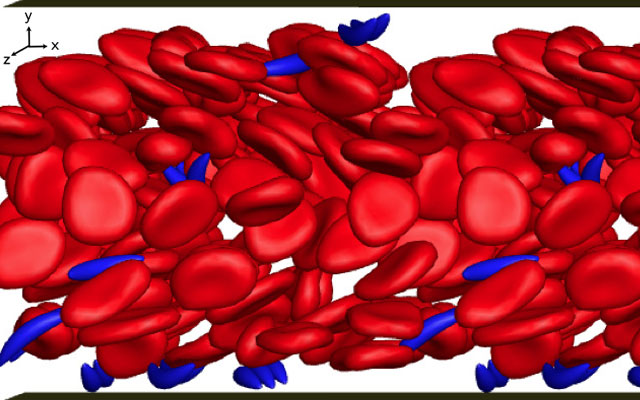By Kimberly Mann Bruch, SDSC Communications
The study, recently published in the Physical Review Fluids journal, reveals new information regarding the ways in which sickle cells collide with one another as well as healthy cells and blood vessel walls.
“Our new simulations showed how the motions of sickle cells near vessel walls generate large forces,” explained the study’s Principal Investigator Michael Graham, a professor of chemical and biological engineering at the University of Wisconsin – Madison. “The forces caused by these sickle cells impact healthy cells on the blood vessel walls, which in turns causes inflammation.”
Graham said the group’s simulations provided evidence regarding damage to healthy cells lining blood vessels, but the origin of this damage is not well understood. “Large-scale shared computing resources such as Comet open doors to doing simulations that could not be done with the resources of an individual research group,” he said.
Graham collaborated with Wilbur Lam, a physician and biomedical engineer at Emory University and the Georgia Institute of Technology. “We are grateful for being able to use supercomputers such as Comet to help us better illustrate, and hopefully come closer to a cure for, sickle cell disease,” said Lam, who is also a pediatric hematologist at Aflac Cancer and Blood Disorders Center of Children’s Healthcare of Atlanta, which has the largest pediatric hematology program in the United States.
Last year, Lam’s dedication to sickle cell disease research was recognized by the Atlanta Business Chronicle as a finalist for the Health Care Innovator/Researcher Award in the Annual Health Care Heroes Awards. In addition to his collaboration with Graham on these latest supercomputer simulations, Lam developed a non-invasive test for anemia that enables anyone at risk for that condition, including sickle cell disease patients, to send an image of their fingernails to measure their hemoglobin levels and determine whether they need to seek medical care.
To learn more about the work of Graham, Lam, and their colleagues, an additional article is available here. This work was supported by the National Science Foundation (CBET-1436082) and the National Institutes of Health (R21MD011590-01A1). The allocations on Comet were allocated by the National Science Foundation’s Extreme Science and Engineering Discovery Environment (TG-CTS190001, TG-MCB190100).
About SDSC
The San Diego Supercomputer Center (SDSC) is a leader and pioneer in high-performance and data-intensive computing, providing cyberinfrastructure resources, services, and expertise to the national research community, academia, and industry. Located on the UC San Diego campus, SDSC supports hundreds of multidisciplinary programs spanning a wide variety of domains, from astrophysics and earth sciences to disease research and drug discovery. In December 2020 SDSC’s newest National Science Foundation-funded supercomputer, Expanse, entered production. At over twice the performance of Comet, Expanse supports SDSC’s theme of ‘Computing without Boundaries’ with a data-centric architecture, public cloud integration, and state-of-the art GPUs for incorporating experimental facilities and edge computing.


